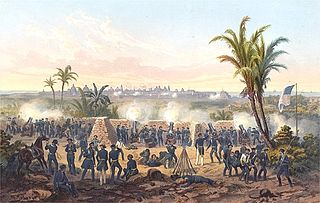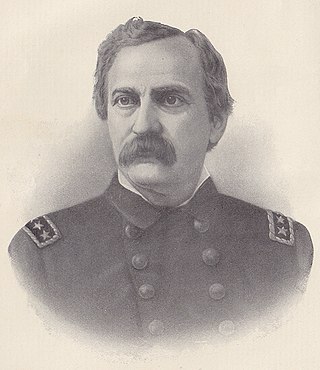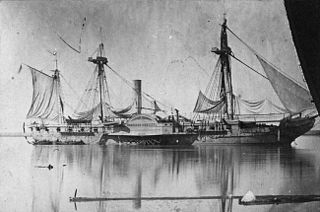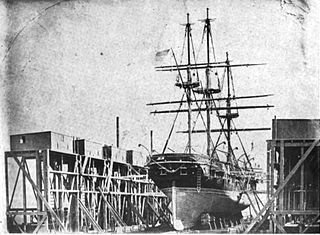
The first USS Raritan was a wooden-hulled, three-masted sailing frigate of the United States Navy built at the Philadelphia Navy Yard, laid down in 1820, but not launched until 13 June 1843, sponsored by Commodore Frederick Engle. She was one of the last sailing frigates of the United States Navy.

The second USS Ohio was a ship of the line of the United States Navy, rated at 74 guns, although her total number of guns was 104. She was designed by Henry Eckford, laid down at Brooklyn Navy Yard in 1817, and launched on 30 May 1820. She went into ordinary and in the ensuing years decayed badly. Refitted for service in 1838, Ohio sailed on 16 October 1838 to join the Mediterranean Squadron under Commodore Isaac Hull. Acting as flagship for two years, she protected commerce and suppressed the slave trade off the African coast. Ohio proved to have excellent performance under sail, repeatedly making more than 12 kn. One of her officers stated, "I never supposed such a ship could be built—a ship possessing in so great a degree all the qualifications of a perfect vessel." In 1840, Ohio returned to Boston, where she again went into ordinary. From 1841 to 1846, Ohio served as receiving ship.

On 9 March 1847, during the Mexican–American War, the United States military made an amphibious landing and besieged the key Mexican seaport of Veracruz. The port surrendered twenty days later. The U.S. forces then marched inland to Mexico City.

David Conner was an officer and commodore of the United States Navy. He served in the War of 1812 and led the Home Squadron during the Mexican–American War. He led the successful naval assault during the siege of Veracruz which included the landing of 10,000 U.S. troops, the largest U.S. military amphibious assault at the time. He served on the Board of Navy Commissioners; as the first Chief of the Bureau of Construction, Equipment, and Repair; as a Special Diplomatic Agent to Mexico and commanded the Philadelphia Naval Yard.

William Harwar Parker was an officer in the United States Navy and later in the Confederate States Navy. His autobiography, entitled Recollections of a Naval Officer 1841–1865, provides a unique insight into the United States Navy of the mid-19th century during an era when the Age of Sail was coming to an end and the advent of steam power and ironclads was beginning.

The Home Squadron was part of the United States Navy in the mid-19th century. Organized as early as 1838, ships were assigned to protect coastal commerce, aid ships in distress, suppress piracy and the Atlantic slave trade, make coastal surveys, and train ships to relieve others on distant stations. It was discontinued in 1861 after the outbreak of the American Civil War, when the Union blockade forced a reassignment of ships to close off Southern ports.

USS Saratoga, a sloop-of-war, was the third ship of the United States Navy to be named for the Battle of Saratoga of the American Revolutionary War. Her keel was laid down in the summer of 1841 by the Portsmouth Navy Yard. She was launched on 26 July 1842 and commissioned on 4 January 1843 with Commander Josiah Tattnall III in command.
USS Germantown was a United States Navy sloop-of-war in commission for various periods between 1847 and 1860. She saw service in the Mexican–American War in 1847–1848 and during peacetime operated in the Caribbean, in the Atlantic Ocean off Africa and South America, and in East Asia. Scuttled at the outbreak of the American Civil War in 1861, she was captured and refloated by the Confederate States of America and placed in service with the Confederate States Navy as the floating battery CSS Germantown before again being scuttled in 1862.

The second USS St. Mary's was a sloop-of-war in the United States Navy.
The fourth USS Spitfire was a sidewheel gunboat in the United States Navy during the Mexican–American War.

The Second Battle of Tabasco, also known as the Battle of Villahermosa, was fought in June 1847 during the Mexican–American War as part of the U.S. blockade of Mexican Gulf ports.

The First Battle of Tabasco was fought during the Mexican–American War, in October 1846, in an attempt to capture cities along the Tabasco coast.
The following are synopsis of the campaigns of the Mexican–American War (1846—1848).
USS Water Witch was a steamer in the service of the United States Navy. She participated in the Mexican–American War which lasted from 1846 to 1848.
USS Fredonia was an 800-ton bark that served the U.S. Navy as a transport and as a storeship. After several voyages to California by way of Cape Horn, she became the station warehouse in Arica, where she was destroyed by an earthquake.
USRC Walter Forward was a schooner constructed for service with the United States Revenue-Marine. She was more commonly known as USRC Forward. Forward served with the United States Army and United States Navy in Mexican waters during the Mexican–American War and was commended for her actions during the Tabasco River landings by Commodore Matthew C. Perry, U.S. Navy. After the war, she was transferred to the United States Coast Survey for a short time as USCS Walter Forward before being returned to the Revenue-Marine for service during the 1850s and the American Civil War.
The third USS Scorpion was a steamer in commission in the United States Navy from 1847 to 1848.

The Battle of Antón Lizardo was a naval engagement of the Mexican civil war between liberals and conservative governments, the Reform War. It took place off the Gulf Coast town of Antón Lizardo, Mexico in 1860. A Mexican Navy officer, Rear Admiral Tomás M. Marín, mutinied and escaped to Havana, Cuba. There he formed a squadron of armed vessels to attack merchant ships and blockade Veracruz. The liberal Mexican Government of Benito Juárez declared Tomás Marín a pirate and permitted foreign navies to attack his ships. Juárez's government was supported by the United States and its navy already had several vessels patrolling in the Gulf of Mexico.
USS Reefer, was a pilot schooner purchased by the United States Navy at New York City on May 25, 1846 from shipbuilders Brown & Bell for service as a dispatch boat in Commodore David Conner's Home Squadron during the Mexican–American War.
The United States Revenue Cutter McLane was one of 4 cutters out of 8 total cutters of the Legere–class iron steamers based on a design by U.S. Navy Lieutenant William Hunter. Hunter sought to eliminate the cumbersome and highly exposed side paddle wheels used on many of the steamers on the period by using wheels that were placed horizontally under the ship. Because of inefficiencies, the design used more coal and was subject to more mechanical failures than other designs. Before McLane was launched the Hunter wheel design was converted to side wheel configuration.









